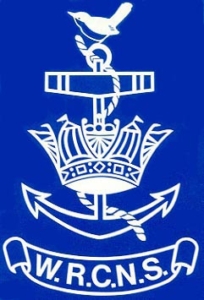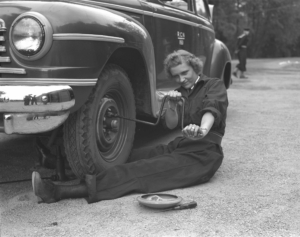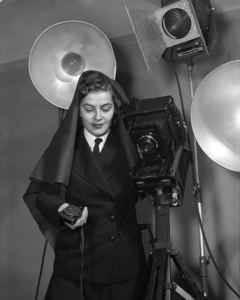
The badge of the Women’s Royal Canadian Naval Service. The wren that sits on top of the anchor is a reference to the name given to the women’s service, ‘Wrens’.
The Navy was the last branch of the Canadian armed forces to accept women as recruits. The Women’s Royal Canadian Naval Service was not established until July 1942, much later than the Women’s Royal Naval Service in Britain (also known as ‘Wrens’).
Canada’s Admiralty was slow to see the importance of bringing women into the RCN. However, by the end of the Second World War, there were more than 6000 regular personnel and officers in the WRCNS.
The fact that women now serve in all aspects of naval operations is mainly due to the hard work and adventurous spirit of the Wrens.
In October, 1942 HMCS BYTOWN II – later CONESTOGA – at Galt (now Cambridge), Ontario became the basic training centre for Wrens from across Canada. The Commanding Officer was Lieutenant Isabel Macneill, the first woman to command a “ship” in the British Commonwealth. As the service expanded and the women proved their worth, they were assigned tasks more closely associated with the war at sea. They staffed operational plots in command headquarters, ran base signal towers, and operated special wireless and Loran (long range navigation) stations, often in remote and lonely parts of the coast. Some 100 Wrens stationed in Britain actively supported the D-Day operation.

WRCNS signallers. The Wren on the left of the photo, operating the signal light, is Margaret MacMillan; Wren Doris Robinson is on the right. Wrens MacMillan and Robinson were some of the first Canadian Wrens to be trained in signals.
Over 6000 Wrens served in World War II. Women served in many occupations previously viewed as exclusively male, sometimes in hazardous locales. By the end of the war, 500 Wrens had served overseas in London, Londonderry, Greenock, Glasgow, Plymouth. Another 500 served in Newfoundland (then an overseas location) and in Washington, DC.
HMCS STADACONA in Halifax had three Wren gunners, as well as three Wrens who worked daily aboard HMCS VENTURE, the headquarters for the RCN’s fleet of sub chasing motor launches. Wren Signallers guided ships into harbour. Signal Towers and W/T stations were ‘womaned’ solely by Wrens.
In Newfoundland, Wren Pay Writers with their Pay Officers went aboard corvettes and other ships as they came into harbour. A Wren officer served as staff driver to the Chief of Naval Staff, Admiral Percy Nelles. The tradition against women’s presence on naval warships was broken when Lt. Cdr. Nancy Pyper and Lt. Agnes McPhee returned from England aboard HMCS OTTAWA in 1945.
It was not all plain sailing for the Wrens. They were paid two-thirds of what the men earned, in keeping with the misguided (and soon to be disproved) notion that it took three women to do the work of two men.
There was also much discrimination, both from within the ranks of the military and from the wider community.
Women in the Navy were not always taken seriously, as this contemporary newspaper article makes clear:
“We don’t know how to spell that two-note whistle, with the emphasis on the last note that is, we believe, the equivalent for “Not bad!” or “Woo-Woo!”, but that’s the one we almost gave a few moments ago. We just saw the trimmest little craft we’ve seen since coming to Navytown. Talk about lines! Why, she was sweeping along there with her sails trimmed and with her soft colors showing up against that blue background – just the loveliest sight a sailor would want to set his eyes on. Is she a schooner or a sloop? You got it all wrong, chum. Heck no, she was a Wren!~ From the March 1943 issue of The Crow’s Nest, the Canadian Navy newspaper.
There were 22 different job categories open to women in the WRCNS, depending on their background and experience.

Hildred Dorothy Driver – nickname “Bobbie” – was a Motor Transport (M/T) worker in the WRCNS. Image HN-374 from the museum’s collection.
The first occupations available to Wren recruits were those which could immediately release men for active duty. By 1943 these choices had greatly expanded. A Wren rating could then choose from the following categories:
Cook, Steward, Wardroom Attendant, Quarters Assistant, Mess Caterer, Supply Assistant, General Clerk, Stenographer, Confidential Book Corrector, Postal Clerk, Secretary, Pay Writer, Administrative Writer, Coder, Telephonist, Telephone Switchboard Operator, Teletype Operator, Plotter, Wireless Telegraphist (W/T), Motor Transport (M/T) Driver, Despatch Rider, Messenger, Sick Berth Attendant.
The Naval Service drew up specific guidelines to measure a job candidate’s ability and aptitude. Here are some examples of how women were evaluated for work as Wrens:
Steward
Previous employment in general domestic service preferred. Women who are used to housework and like it can be trained.
Plotter
Secondary school education. Neat at figures. Should have a quick, clear brain and some mathematical ability. Must be steady and not easily flustered.
Sick berth attendant
Of good education, preferably two years or more of High School; should not be timid when exposed to sickness or disease or sight of blood.
Coder
Secondary school experience. Must be able to type. Bright, intelligent girls are required for this work
Just one year after the WRCNS was established, the Wrens were already earning high praise for their efforts. Their contribution to naval morale and efficiency was noted by Vice Admiral Percy W. Nelles, Chief of Naval Staff –
“I wish to thank the patriotic women who have entered their country’s service and have added so capably to the combat strength of the navy by helping to man the shore establishments in this country. In one short year you have proved yourselves of immeasurable value to the naval service by taking over many tasks with skill, diligence and cheerfulness. As Chief of Naval Staff, I am proud of your record and the contribution you are making to the final victory.”
Here is a list of books relating to the Wrens in Canada and the U.K., plus books that deal with women’s service in the Armed Forces in general, particularly during WWII. Please note that some of these works are self-published reminiscences by retired Wrens and may be out of print or difficult to obtain:
Proudly She Marched: Training Canada’s World War II Women in Waterloo County, Volume 2: Women’s Royal Canadian Naval Service – history by Anne Kallin. ISBN 978-0-9781427-1-1 (v.2). Published by the Canadian Federation of University Women, Kitchener-Waterloo, Waterloo, Ontario
A History of Women in the Canadian Military – history by Barbara Dundas. ISBN 2-920718-79-7. Published by Art Global, 384 Laurier Avenue West, Montreal, Quebec
On the Double, Matilda! One woman’s story of life as a Wren – memoir by Audrey Sim Shortridge. ISBN 8-76543-363-4. Published by CFB Esquimalt Naval & Military Museum, copyright 2006
Equal to the Challenge – An Anthology of Women’s Experiences During World War II – based on interviews with 55 women recounting their experiences during the Second World War, produced by Lisa Banister. National Defence publication.
Greatcoats and Glamour Boots: Canadian Women at War (1939-1945), Revised Edition – history by Carolyn Gossage. ISBN 1-55002-368-3. Published in Canada by the Dundurn Press.
Ten for a Wren – self-published memoir of the WRNS by Sybil Barrett. ISBN 978-1-4251-2037-5. Trafford Publishing.
WREN: memories of navy days from royal yacht to quonset hut – memoir by Rosalee Auger van Stelten. ISBN 978-0-9865254-1-4. Distributed by the Esquimalt Military Family Resource Centre
Invisible Women: WWII Aboriginal Servicewomen in Canada – historical research by Grace Poulin. ISBN 978-0-9784585-0-8. Printed by Lehto Rainbow Printers Ltd., Thunder Bay, Ontario
I Go (Not) Down to the Sea in Ships – memoir by Dorothy Robertson, a Wren who served at the Naval Radio Station at Gloucester, available here in PDF format
A Duffle Bag, Close Friends and Lots of Memories: The Photo Diary of Marion Swinton, W.R.C.N.S. – edited by Michelle Fowler. ISBN 978-0-9783441-8-4. LCMSDS Press, Wilfrid Laurier University, Waterloo, Ontario
It’s a Galley, Not a Kitchen, You Landlubber ! – memoir by Margaret Claire (Fisher) Hamilton. ISBN 978-0-9681353-3-4. Distribution information – c/o E. Hamilton, 1092 Route 105, Douglas, NB E3G 7J6. Hamilton@unbc.ca
Back the Attack! Canadian Women During the Second World War – at Home and Abroad – by Jean Bruce. Published by Macmillan of Canada, c. 1985
“They’re Still Women After All”: The Second World War and Canadian Womanhood – by Ruth Roach Pierson. Toronto, McClelland and Stewart, c 1986. ISBN 0-7710-6958-8
Framing Our Past – Constructing Canadian Women’s History in the Twentieth Century. Edited by Sharon Anne Cook, Lorna McLean and Kathryn O’Rourke. McGill-Queen’s University Press, July 2006. ISBN 9780773531598
Blue Tapestry – memoir/history by Vera Laughton Mathews, Director of the W.R.N.S. in the U.K. from 1939-1946. Published by Hollis & Carter, London, 1949
Sally Grayson: Wren – fiction by Joan Llewelyn Owens, published in 1954 in the U.K. by The Bodley Head Limited
Requiem for a Wren – fiction by Nevil Shute, published in 1955 in the U.K. by Wiliam Clowes and Sons, Limited, London and Beccles
Army Daze – From Cranbrook to Apeldoorn: Life in a Man’s Army – Memoir by Doris Ann Boileau. ISBN 978-0-9868105-0-3. Published by Aldridge Street Publishing, Victoria BC
Deep Sea ‘Sparks’ – A Canadian Girl in the Norwegian Merchant Navy – by Olive J. Carroll. ISBN 1-895590-05-1. Published by Cordillera Publishing Company, Box 46, 8415 Granville Street, Vancouver BC
Please let us know if there are other publications relating to the history of the Women’s Royal Canadian Naval Service or the Women’s Royal Naval Service that should be included in the above list.


 CFB Esquimalt Naval and Military Museum
CFB Esquimalt Naval and Military Museum CFB Esquimalt Naval and Military Museum
CFB Esquimalt Naval and Military Museum CFB Esquimalt Naval and Military Museum
CFB Esquimalt Naval and Military Museum
 CFB Esquimalt Naval and Military Museum
CFB Esquimalt Naval and Military Museum CFB Esquimalt Naval and Military Museum
CFB Esquimalt Naval and Military Museum
 CFB Esquimalt Naval and Military Museum
CFB Esquimalt Naval and Military Museum

 CFB Esquimalt Naval and Military Museum
CFB Esquimalt Naval and Military Museum CFB Esquimalt Naval and Military Museum
CFB Esquimalt Naval and Military Museum
 CFB Esquimalt Naval and Military Museum
CFB Esquimalt Naval and Military Museum